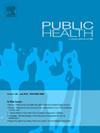Spatio-temporal patterns of prostate-specific antigen testing in asymptomatic men: a population-based cohort study, Australia, 2002–2018
IF 3.9
3区 医学
Q1 PUBLIC, ENVIRONMENTAL & OCCUPATIONAL HEALTH
引用次数: 0
Abstract
Objective
Prostate-specific antigen (PSA) testing rates vary by small geographical area in Australia, yet little is known about how these variations have changed over time. This study aims to examine spatio-temporal patterns in Australia during 2002–2018.
Study design
Retrospective population-based cohort study.
Methods
We obtained Medicare Benefit Schedule data on PSA testing (n = 9,342,134) during 2002–2018 from the Commonwealth Department of Health, Australia for men aged 50–79 years. Postcodes were mapped to statistical areas level 2 (n = 2133) using a probability-based correspondence file and multiple (n = 50) iterations. Bayesian spatio-temporal models were used to generate indirectly standardized incidence ratios for each small area over time compared to the national average.
Results
The annual percentage of men aged 50–79 who received a PSA test for asymptomatic testing increased from 15·6 % up to 24·5 % in 2008, before declining to 14·8 %. Geographical patterns of PSA testing varied substantially over time, with many areas deviating from the national trend. Between 2002 and 2008, 80 % of small areas had testing rates increase, while 93 % of areas decreased from 2008 to 2018. East coast and southwest regions of Australia, primarily major cities and regional areas, exhibited the most divergent temporal trends, while many remote areas maintained consistently low testing rates.
Conclusion
The extent and patterns of geographic variation in PSA testing rates across small areas has changed over time. Understanding the reasons for this variation remains a priority, to help ensure all men at risk have equitable access to relevant decision-making process and information about PSA testing.
无症状男性前列腺特异性抗原检测的时空模式:一项基于人群的队列研究,澳大利亚,2002-2018
在澳大利亚,前列腺特异性抗原(PSA)检测率因地理区域的不同而不同,但人们对这些差异是如何随时间变化的知之甚少。本研究旨在研究2002-2018年澳大利亚的时空格局。研究设计:基于人群的回顾性队列研究。方法:我们从澳大利亚联邦卫生部获得2002-2018年期间50-79岁男性的PSA检测的医疗保险福利计划数据(n = 9,342,134)。使用基于概率的通信文件和多次(n = 50)迭代将邮政编码映射到统计区域级别2 (n = 2133)。贝叶斯时空模型用于与全国平均水平相比,产生每个小区域随时间的间接标准化发病率。结果50-79岁男性每年接受PSA无症状检测的比例从2008年的15.6%上升到24.5%,然后下降到14.8%。随着时间的推移,PSA检测的地理模式变化很大,许多地区偏离了全国趋势。从2002年到2008年,80%的小地区的检测率上升,而从2008年到2018年,93%的地区的检测率下降。澳大利亚东海岸和西南地区(主要是主要城市和区域)的时间趋势差异最大,而许多偏远地区的检测率一直保持在较低水平。结论小区域PSA检测率的地理差异程度和模式随着时间的推移而变化。了解这种差异的原因仍然是一个优先事项,以帮助确保所有有风险的男性公平地获得有关PSA检测的决策过程和信息。
本文章由计算机程序翻译,如有差异,请以英文原文为准。
求助全文
约1分钟内获得全文
求助全文
来源期刊

Public Health
医学-公共卫生、环境卫生与职业卫生
CiteScore
7.60
自引率
0.00%
发文量
280
审稿时长
37 days
期刊介绍:
Public Health is an international, multidisciplinary peer-reviewed journal. It publishes original papers, reviews and short reports on all aspects of the science, philosophy, and practice of public health.
 求助内容:
求助内容: 应助结果提醒方式:
应助结果提醒方式:


